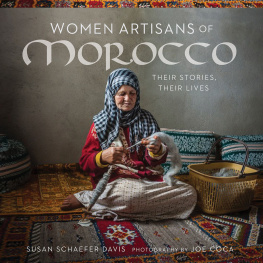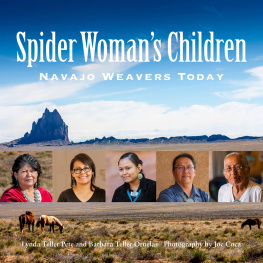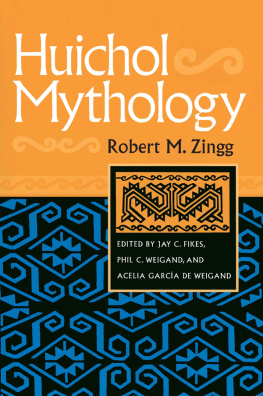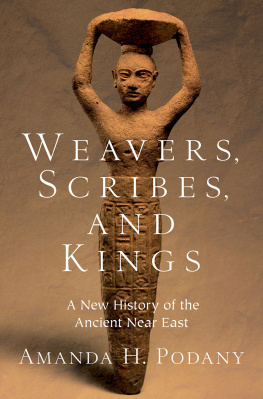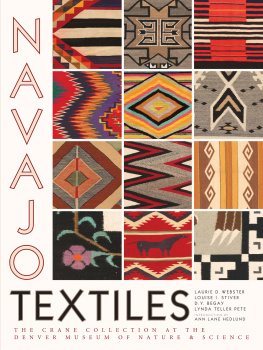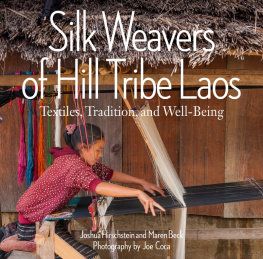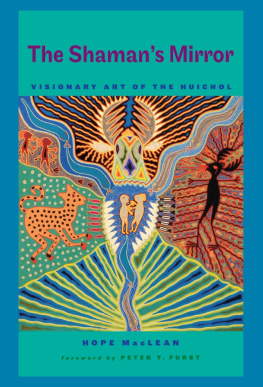Huichol Women, Weavers, and Shamans
Huichol Women,
Weavers,
and Shamans
STACY B. SCHAEFER
2015 by the University of New Mexico Press
All rights reserved. Published 2015
Printed in the United States of America
20 19 18 17 16 15 1 2 3 4 5 6
The Library of Congress has cataloged the printed edition as follows:
Schaefer, Stacy B., 1956
[To think with a good heart]
Huichol women, weavers, and shamans / Stacy B. Schaefer.
pages cm
Includes bibliographical references and index.
ISBN 978-0-8263-5581-2 (paperback) ISBN 978-0-8263-5582-9 (electronic)
1. Huichol women. 2. Huichol textile fabrics. I. Title.
F1221.H9S33 2015
305.408974544dc23
2014033694
Cover illustration: Women affixing small beeswax figures of deer to the pine boughs associated with the hunt. Photograph by Stacy B. Schaefer.
Frontispiece illustration: Iyari (heart memory) design woven by the author. Photograph by Stacy B. Schaefer.
Chapter opener illustration: (detail) Double-weave bag with designs of the iyari of the birds. Photograph by Stacy B. Schaefer.
To the living memory of my parents,
Jackie and Gersch,
and to my comadre,
K+paima,
for having touched my life with love, inspiration,
and new ways of seeing the world.
For my compaero, Jim,
for Susana,
Esther, and Jo,
and the Denwar Workshop,
who all encouraged me to follow my dreams.
THE ART OF THINKING WITH A GOOD HEART
You have to remain careful, thinking all of your life.
Gabriela
You have to want to learn weaving. You have to think that the work you are doing was done by Takutsi Nakawe [Grandmother Goddess of Growth and Creation]. You have to ask for these thoughts.
Yolanda
You also have to think this way. Even though you do not know our gods, you are recording our thoughts. Thats how one should think. One understands very easily if she thinks as we do. The Sun as it passes hears, it hears our memory, it hears us, and we learn that which the women know.
Andrea
Contents
INTRODUCTION
Spinning the Thread
CHAPTER 1
Origins of Flesh and Fabric
CHAPTER 2
Two Families of Women and Their Weaving Ways
CHAPTER 3
Women and Men
CHAPTER 4
Weaving from Girls to Women
CHAPTER 5
The Economics of Weaving
CHAPTER 6
Awakening the Heart-Memory
The Religious Aspects of Weaving
CHAPTER 7
The Art of Weaving Symbols
CHAPTER 8
Weavers, Shamans, and Goddesses
EPILOGUE
Weaving the Future
APPENDIX A
Weaving Technology
APPENDIX B
Huichol Female Names
Illustrations
Acknowledgments
THIS PUBLICATION WAS over 15 years in the making, and many individuals have contributed in a variety of ways over the course of its inception and evolution. First and foremost, I would like to thank my parents for backing me selflessly during this major undertaking. Although they were not able to see this work come to print, they, too, felt strong ties to my life and to the families in the Sierra, and they will always be with me in my heart. I am forever grateful to Jim Bauml, who, as my loving, supportive husband, compaero, friend, and colleague, has shared his knowledge of Huichol ethnobotany, helped in collecting and identifying botanical specimens, and patiently read, reread, and edited numerous drafts of this work. My deeply felt gratitude goes to Susana Eger Valadez; without her friendship, help, and guidance, this research would not have been possible. Special thanks go to Peter T. Furst for providing me with solid encouragement and advice and for helping to edit various drafts of the manuscript. To Johannes Wilbert, who will always be my mentor, I extend my appreciation for encouraging me to continue my long-term fieldwork among the Huichol, and for the many detailed conversations we shared, which have provided me with ideas to explore and important tools to help unlock the significance and meaning of weaving in Huichol culture. I am especially grateful to John Byram, director of the University of New Mexico Press, and his amazing staff for recognizing the importance of this work and for their support to ensure that it remains current and available in print and as an e-book. Many thanks also go to Jeff Grathwohl, publisher of the first edition of this book, for his patient support and trust, as well as the staff at the University of Utah Press for bringing this work to fruition. I also thank my original editor, fellow weaver and anthropologist Joan ODonnell, for weathering the internet chaos caused by New Mexicos summer monsoons to complete a beautiful and meticulous editing job.
With the reprint of this book, I would like to thank a number of additional people whose contributions have been important to this work and to my life. Many thanks go to Lisa Feintech; Manolo and Donna Torres and family; Sasha and Ann Shulgin along with Tanya and Gregg Manning and the Shulgin Team; Jonathan Ott; Rob Montgomery; Keeper Trout and Geoffrey Pomeroy; Martin Terry; Ben Kamm; Alejandro de vila Bloomberg and Hector Manuel Meneses Lozano of the Museo Textil de Oaxaca; Mexico City artist Santiago Borja; Pueblo weaver and teacher extraordinaire Luis Garca of New Mexico; artists Lida Penkova and Daniel Doherty of Humboldt County, CA; the younger Kal Muller; Carolyn Boyd, founder and director of SHUMLA in Comstock, TX; Tony Burton of Geo-Mexico; Vanessa Leong; Deb Besnard, Special Collections librarian at California State University, Chico; Heather McCafferty; and Farzaneh Razzaghi, University Library director at the University of Texas-Pan American.
Among my colleagues at UCLA, I am grateful to all of Johannes Wilberts Thursday night group, to Paul Kroskrity for his valuable advice and support, including many hours spent going over basic linguistic principles with me, and to Cecelia Klein for her insightful comments on gender in Mesoamerican culture and the arts. I am indebted to Chris Donnan, Doran Ross, Patricia Altman, the late Dorothy Mann Cordry, Betsy Escandor, and the rest of the staff at the Fowler Museum of Cultural History at UCLA for giving me the opportunity to pursue research on the Huichol collection at the museum. I am also grateful to the National Museum of the American Indian; to the American Museum of Natural History, New York, for allowing one to view the Lumholtz collection and for permission to reproduce some of his photographs; to the Laboratory of Anthropology in Santa Fe, New Mexico; and to the Southwest Museum. Kathleen Berrin, now retired from the Fine Arts Museums of San Francisco, and Tom Seligman, also retired, from the Stanford University Museum and Art Gallery have had an important influence on my life and career by recognizing my dedication to the field and encouraging me to continue. I am grateful to the faculty in the Anthropology and Latin American Studies departments at the University of California at Santa Cruz for their support and encouragement during my initial fieldwork among the Huichol while I was an undergraduate.


